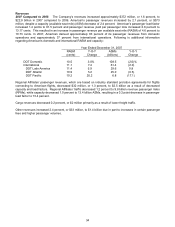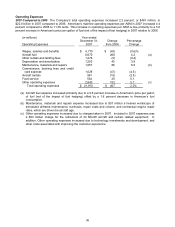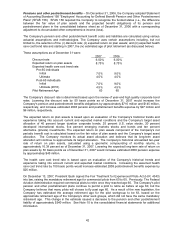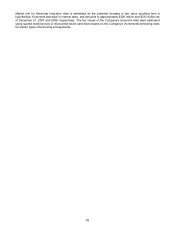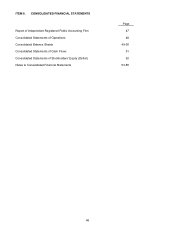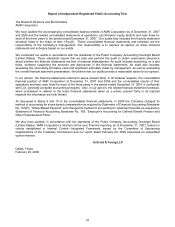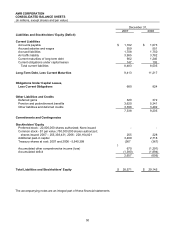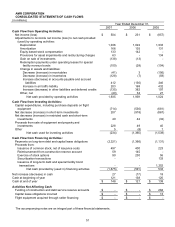American Airlines 2007 Annual Report Download - page 45
Download and view the complete annual report
Please find page 45 of the 2007 American Airlines annual report below. You can navigate through the pages in the report by either clicking on the pages listed below, or by using the keyword search tool below to find specific information within the annual report.
42
Pensions and other postretirement benefits – On December 31, 2006, the Company adopted Statement
of Accounting Standard 158 “Employers’ Accounting for Defined Benefit Pension and Other Postretirement
Plans” (SFAS 158). SFAS 158 required the Company to recognize the funded status (i.e., the difference
between the fair value of plan assets and the projected benefit obligations) of its pension and
postretirement plans in the consolidated balance sheet as of December 31, 2006 with a corresponding
adjustment to Accumulated other comprehensive income (loss).
The Company’s pension and other postretirement benefit costs and liabilities are calculated using various
actuarial assumptions and methodologies. The Company uses certain assumptions including, but not
limited to, the selection of the: (i) discount rate; (ii) expected return on plan assets; and (iii) expected health
care cost trend rate and starting in 2007, the (iv) estimated age of pilot retirement (as discussed below).
These assumptions as of December 31 were:
2007 2006
Discount rate 6.50% 6.00%
Expected return on plan assets 8.75% 8.75%
Expected health care cost trend rate:
Pre-65 individuals
Initial 7.0% 9.0%
Ultimate 4.5% 4.5%
Post-65 individuals
Initial 7.0% 9.0%
Ultimate (2010) 4.5% 4.5%
Pilot Retirement Age 63 60
The Company’s discount rate is determined based upon the review of year-end high quality corporate bond
rates. Lowering the discount rate by 50 basis points as of December 31, 2007 would increase the
Company’s pension and postretirement benefits obligations by approximately $710 million and $145 million,
respectively, and increase estimated 2008 pension and postretirement benefits expense by $27 million and
$6 million, respectively.
The expected return on plan assets is based upon an evaluation of the Company's historical trends and
experience taking into account current and expected market conditions and the Company’s target asset
allocation of 40 percent longer duration corporate bonds, 25 percent U.S. value stocks, 20 percent
developed international stocks, five percent emerging markets stocks and bonds and ten percent
alternative (private) investments. The expected return on plan assets component of the Company’s net
periodic benefit cost is calculated based on the fair value of plan assets and the Company’s target asset
allocation. The Company monitors its actual asset allocation and believes that its long-term asset
allocation will continue to approximate its target allocation. The Company’s historical annualized ten-year
rate of return on plan assets, calculated using a geometric compounding of monthly returns, is
approximately 10.39 percent as of December 31, 2007. Lowering the expected long-term rate of return on
plan assets by 50 basis points as of December 31, 2007 would increase estimated 2008 pension expense
by approximately $45 million.
The health care cost trend rate is based upon an evaluation of the Company's historical trends and
experience taking into account current and expected market conditions. Increasing the assumed health
care cost trend rate by 100 basis points would increase estimated 2008 postretirement benefits expense by
$25 million.
On December 13, 2007, President Bush signed the Fair Treatment for Experienced Pilots Act (H.R. 4343)
into law, raising the mandatory retirement age for commercial pilots from 60 to 65. Previously, The Federal
Aviation Administration required commercial pilots to retire once they reached age 60. The Company’s pilot
pension and other postretirement plans continue to permit a pilot to retire as before at age 60, but the
Company believes that many pilots will choose to fly past age 60. As a result of the new legislation, the
Company has estimated the average retirement age for the pilot workgroup to be 63, based on the
approximate retirement age of the Company’s other work groups, which did not have the same mandatory
retirement age. This change in the estimate caused a decrease to the pension and other postretirement
liability of approximately $540 million. See Note 10 to the consolidated financial statements for additional
information.




